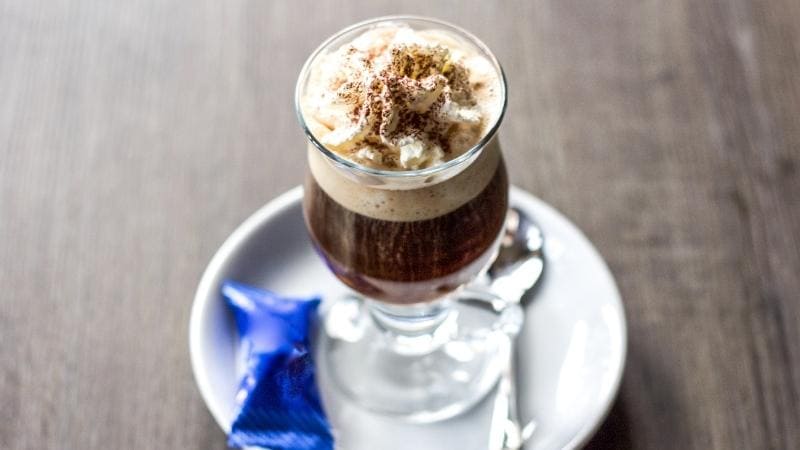
When I need a strong concoction to stay alert and keep my wits about me, I know I can never go wrong with Spanish coffee or Mexican coffee. Just a shot of either of these is enough to increase my energy levels and significantly improve my productivity.
So, how do these two types of coffee drinks compare?
Spanish Coffee Vs Mexican Coffee
In the U.S., Spanish coffee refers mostly to the American version of the carajillo – spiked coffee. Carajillo is made by first igniting high proof rum in a glass to caramelize the sugar rim, before adding coffee, Triple Sec, and Kahlua. The drink is served with nutmeg and whipped cream toppings.
Generally speaking, however, there are different types of Spanish coffee with different brewing processes and tastes.
What is Mexican Coffee?
The basic definition of Mexican coffee is a combination of potent, freshly roasted coffee, cinnamon, and chocolate. Like Spanish Coffee, Mexican coffee has several variations, with Café de olla being the most popular.
Café de olla is basically coffee brewed in a clay pot known as an olla, with the addition of cinnamon and piloncillo (cane sugar). The sugar and cinnamon are incorporated into the coffee during the brewing process to produce a sweet and spicy drink.
Spanish vs Mexican Coffee Beans
Mexican coffee beans are usually lightweight with a unique nutty flavor. The beans make fine, delicate coffee. Some are extremely dry and acidic, like white wine. The most common types of Mexican coffee beans include:
Chiapas coffee
Chiapas is a southern state in Mexico. It was the first region in the country to cultivate coffee beans and it is still the leading exporter, producing up to 40 percent of the total coffee in Mexico.
The hot and tropical climate in Chiapas makes it perfect for growing coffee beans. Additionally, the soil is fertile and rich in nutrients due to the surrounding volcanoes, which allows the crops to thrive.
Chiapas coffee beans are round and solid, with hints of chocolate, lemon, citrus, and nuts. Café de Altura beans are also grown in Chiapas. “Altura” means “heights” – which is quite fitting as the beans grow well at an altitude of 3,000-4,000 feet. The coffee from these beans has a smooth and nutty texture with some flavors of hazelnut.
Veracruz coffee
Veracruz is nestled on the Gulf of Mexico. Its lowland regions are known for producing average-tasting beans. The highland region is where all the magic is with its highly-sought-after Altura Coatepec beans. The coffee from these crops has moderate acidity and a rich aroma with a nutty flavor, floral notes, and a smooth finish.
Spanish Coffee Beans
Spanish coffee beans are cultivated on the Canary Islands. The altitude, climate, and lack of direct sunlight make the region suitable for growing the coffee beans. Main varieties include Caturra, Geisha, and Robusta.
You’ll notice that Spanish coffee often comes with a slightly bitter taste. This coffee is referred to as “torrefacto”. It is made by combining sugar with coffee beans before roasting. The resultant bitter, acrid taste is the signature of Spanish coffee.
Spanish Coffee Drinks
i) Café Solo
Café solo is one of the most common types of Spanish coffees. It is basically a shot of espresso with a thick, bitter, and deep flavor. The coffee is made by forcing hot water through ground beans. It is then served into a ceramic cup or a short, tiny glass with a spoon, saucer, and a bag of sugar.
ii) Café Americano
If the Café Solo is too strong for you, try a cup of Café Americano. This is a slight variation of the café solo with added water to reduce the bitterness.
iii) Café Cortado
This coffee drink is also based on espresso, with the addition of steamed milk to reduce the acidity. To make a café cortado, simply add 80 ml of milk for every 60 ml of coffee. Then add sugar.
Another version of an espresso based drink is the cortadito, not to be confused with the Cortado. The two drinks are quite different.
iv) Café Manchado
In this variation, milk takes precedence over the espresso. That is, the drink is made up of mostly milk with a stain of coffee. However, you should note that “Manchado” can mean very different things in different regions in Spain. In some places, the term actually means coffee with a stain of milk.
In this case, a leche manchada is what you should order if you need minimal coffee in your drink. So, if you are in Spain, be sure to enquire about the local coffee custom.
v) Café con Leche
Café con Leche also contains milk that is scalded by a steaming wand. It goes well with tasty merienda treats such as shortbread and cookies.
To make a café con Leche, simply brew equal parts (30ml 1oz) of whole milk and espresso.
vi) Café Bombon
This drink is a visual delight made by gently adding condensed milk to espresso. You can actually see the coffee and milk splitting into two thick segments.
vii) Café Con Hielo
If you ask for a Café con Hielo, you will get “normal coffee” and ice in a separate glass. You should pour the coffee into the glass of ice. It is basically the Spanish version of iced coffee.
viii) Barraquito
This coffee is made of multiple layers of condensed milk, frothed milk, espresso, and a spot of Tia Maria or Licor 43. The drink is so sweet, it is usually served as a dessert.
ix) Café Carajillo
When you say “Spanish coffee” in America, this is typically what pops up in most people’s minds – coffee spiked with rum then served with a topping of whipped cream.
In Spain, the drink is similar but they use brandy instead of rum. It is basically a café solo enhanced with a shot of brandy. To make a proper café Carajillo, you need to lit the brandy first to burn off the alcohol before you add the coffee.
Mexican Coffee Drinks
I) Traditional Mexican Coffee
Sweet flavors are incorporated into the light-bodied Mexican coffee beans to create a traditional Mexican coffee.
Here’s how to make this delicious drink:
Ingredients
- Whipped cream
- 2 teaspoons of vanilla extract
- 1/3 cup of chocolate syrup
- 2 tablespoons of brown sugar
- 1 cup heavy cream
- 2 teaspoons of ground cinnamon (and extra for garnish)
- 5 cups of water
- 1/2-3/4 cup of Mexican coffee grounds
Directions
Combine the water, cinnamon, and coffee grounds in a coffee pot and start brewing.
Meanwhile, mix the chocolate syrup, brown sugar, and heavy cream in a small saucepan. Simmer the mixture over low heat. Turn the stove off and stir in vanilla extract.
Pour the brewed coffee into the chocolate syrup mixture and mix. Serve topped with whipped cream and a sprinkle of cinnamon.
II) Iced Horchata Latte
Horchata Latte is a type of Mexican coffee that consists of one shot of espresso with homemade cinnamon rice milk. During the warmer months, you can cool down by adding ice to your Horchata Latte. Here’s a sample recipe:
Ingredients
- 1 teaspoon of vanilla extract
- 3 teaspoons of maple syrup
- 2 cinnamon sticks
- 1/2 cup of raw almonds
- 1/2 cup of brown rice
- 4 cups of filtered water
- 4 shots of Mexican espresso
Directions
Mix two cups of water, cinnamon sticks, almonds, and rice in a large jar. Set the jar aside for 8 to 24 hours.
Transfer the mixture into a mixing bowl and add the remaining 2 cups of water. Process with a high speed blender for two minutes on high then strain. Add the vanilla extract and maple syrup.
Pour the mixture in a glass filled with ice. Add the espresso and top with whipped cream.
III) Spiked Mexican Coffee
Like Spanish coffee, there is also a sweet variation of spiked Mexican coffee. Here’s how to make it:
Ingredients
2 tablespoons of whipped cream
½ shot of tequila
1 shot of Kahlua
1/2 cup of brewed Mexican coffee
Directions
Combine the tequila and Kahlua in a coffee mug. Pour your brewed coffee into the mug and enjoy with a topping of whipped cream!
Spanish coffee vs Mexican Coffee History
Spanish Coffee History
Coffee was originally brought to Spain by Turkish immigrants. They didn’t grow the coffee in Spain, but they had a way of roasting the beans until they were extremely dark (almost black) and oily. These beans produced very strong coffee, which we refer to as Dark French Roast or Spanish Roast today.
Jose Gomez Tejedor later introduced the torrefacto brewing process to Spain. On a trip to Mexico, Jose saw miners roasting sugar onto coffee beans to make them last longer.
He was impressed by this process not only for making the coffee beans last longer but also because it uses fewer beans and increases the volume of the roast via the added sugar without affecting the cost.
What’s more, a torrefacto contains more antioxidant properties than regular roast. Most Spanish coffee variations are based on the sweet, dark, oily torrefacto roast.
Mexican Coffee History
Mexican coffee was originally introduced by European settlers in the late 1700s. When they moved to Mexico, the settlers bought large fields of land specifically for harvesting coffee beans.
They then hired Mexican laborers to do the cultivation and turn the beans into delicious coffee before shipping it back to Europe.
Mexico began cultivating some of the world’s best coffee beans during the eighteenth century. In 1973, the Mexican government founded the National Coffee Institute of Mexico (INMECAFE) to fund rural farmers and increase the production of coffee due to the soaring demand.
The program provided the farmers with transportation, equipment, and credit so that they could export their coffee. As a result, production of Mexican coffee surged by a staggering 900 percent from 1973 to 1990.
Unfortunately, INMECAFE collapsed in 1989 after the Mexican government over-borrowed and failed to repay its loans, causing coffee production to drop significantly. (Source)
Over the years, cooperative groups have been formed to replace the program and boost local organic coffee farms. Mexican coffee is grown mostly in southern Mexico, but you can also find it being cultivated across sixteen Mexican states.
